Effective Detoxification of Olive Mill Wastewater Using Multi-Step Surfactant-Based Treatment: Assessment of Environmental and Health Impact
Abstract
1. Introduction
2. Results and Discussion
2.1. Coagulation–Flocculation–Sedimentation
2.2. Selection of Surfactant and Determination of Total Phenolic Compounds
2.3. Germination Assay
2.4. Liquid Chromatography–Mass Spectrometry Analysis
2.5. Gas Chromatography–Mass Spectrometry Analysis
2.6. Inductively Coupled Plasma Mass Spectrometry Analysis
2.7. High Chemical Oxygen Demand (COD)
2.8. Bacteria Toxicity Assay
2.9. MTT Assay
2.10. Possible Use for Mass Productions
3. Materials and Methods
3.1. Chemicals and Materials
3.2. Methods
3.2.1. Purification Steps
Pretreatment
Coagulation–Flocculation–Sedimentation
Micellar Distillation Treatment
3.2.2. Total Phenolic Compounds
3.2.3. Germination Assay
3.2.4. High Chemical Oxygen Demand (COD)
3.2.5. Liquid Chromatography–Mass Spectrometry Analysis (LC–MS)
3.2.6. Gas Chromatography–Mass Spectrometry Analysis (GC–MS)
3.2.7. Inductively Coupled Plasma Mass Spectrometry Analysis (ICP–MS)
3.2.8. Anti-Bacterial Activity
3.2.9. Cell Culture Assay
3.2.10. Statistical Analysis
4. Conclusions
- The treatment process, involving screening, coagulation with various chemicals, and distillation with different surfactants, effectively reduced the environmental and health impacts of OMW.
- Monitoring via LC–MS, GC–MS, ICP–MS, chemical oxygen demand (COD), and total phenolic compounds confirmed the efficacy of the process.
- GC–MS and LC–MS show that the total number of contaminants was reduced significantly.
- The chemical oxygen demand in treated OMW was reduced by 66%.
- The polyphenol contents were reduced by 98%.
- The treatment process interfered with the metals, resulting in the following reductions: Cu (45%), Ni (57%), Fe and Ba (70%), Na (80%), Zn, Mg, K, Ca, Mn, and Sr (more than 95%). All other heavy metals (Hg, Pb, Cd, As, and Mo) were under the detection limit in the raw samples.
- The toxicity of treated OMW was successfully improved: 100% in germination assay, 100% elimination of mold growth, 95% on human cells, and 100% on fluorescence bacteria.
- The potential use on a large scale was also discussed, and solutions were offered.
- The overall reduction in pollutants and toxicity highlights the potential of using SDS micelles for OMW detoxification, offering a viable solution for environmental management in olive-producing regions.
- Future work may focus on mass production.
Supplementary Materials
Author Contributions
Funding
Institutional Review Board Statement
Informed Consent Statement
Data Availability Statement
Acknowledgments
Conflicts of Interest
References
- Yangui, A.; Abderrabba, M.; Sayari, A. Amine-modified mesoporous silica for quantitative adsorption and release of hydroxytyrosol and other phenolic compounds from olive mill wastewater. J. Taiwan Inst. Chem. Eng. 2017, 70, 111–118. [Google Scholar] [CrossRef]
- Jamrah, A.; Al-Zghoul, T.M.; Darwish, M.M. A comprehensive review of combined processes for olive mill wastewater treatments. Case Stud. Chem. Environ. Eng. 2023, 8, 100493. [Google Scholar] [CrossRef]
- Raiti, J.; Hafidi, A. Mixed micelles-mediated dephenolisation of table olive processing’s wastewaters. Water Sci. Technol. 2015, 72, 2132–2138. [Google Scholar] [CrossRef]
- Bazoti, F.N.; Gikas, E.; Skaltsounis, A.L.; Tsarbopoulos, A. Development of a liquid chromatography–electrospray ionization tandem mass spectrometry (LC–ESI MS/MS) method for the quantification of bioactive substances present in olive oil mill wastewaters. Anal. Chim. Acta 2006, 573, 258–266. [Google Scholar] [CrossRef]
- Al-Qodah, Z.; Al-Shannag, M.; Bani-Melhem, K.; Assirey, E.; Alananbeh, K.; Bouqellah, N. Biodegradation of olive mills wastewater using thermophilic bacteria. Desalination Water Treat. 2015, 56, 1908–1917. [Google Scholar] [CrossRef]
- Sarris, D.; Rapti, A.; Papafotis, N.; Koutinas, A.A.; Papanikolaou, S. Production of added-value chemical compounds through bioconversions of olive-mill wastewaters blended with crude glycerol by a Yarrowia lipolytica strain. Molecules 2019, 24, 222. [Google Scholar] [CrossRef] [PubMed]
- Neffa, M.; Hanine, H.; Lekhlif, B.; Taourirt, M.; Habbari, K. Treatment of wastewaters olive mill by electrocoagulation and biological process. Linnaeus Eco-Tech 2010, 295–304. [Google Scholar] [CrossRef]
- Roig, A.; Cayuela, M.L.; Sánchez-Monedero, M.A. An overview on olive mill wastes and their valorisation methods. Waste Manag. 2006, 26, 960–969. [Google Scholar] [CrossRef]
- Khdair, I.A.; Abu-Rumman, G. Evaluation of the environmental pollution from olive mills wastewater. Fresenius Environ. Bull 2017, 26, 2537–2540. [Google Scholar]
- da Silva, A.N. Treatment of Wastewater from the Olive Pomace Oil Extraction Industry by Fenton; Federal University of Technology: Paraná, Brazil, 2023. [Google Scholar]
- Jakobek, L. Interactions of polyphenols with carbohydrates, lipids and proteins. Food Chem. 2015, 175, 556–567. [Google Scholar] [CrossRef]
- Souilem, S.; El-Abbassi, A.; Kiai, H.; Hafidi, A.; Sayadi, S.; Galanakis, C.M. Olive oil production sector: Environmental effects and sustainability challenges. In Olive Mill Waste; Elsevier: Amsterdam, The Netherlands, 2017; pp. 1–28. [Google Scholar]
- Cibelli, F.; Bevilacqua, A.; Raimondo, M.L.; Campaniello, D.; Carlucci, A.; Ciccarone, C.; Sinigaglia, M.; Corbo, M.R. Evaluation of fungal growth on olive-mill wastewaters treated at high temperature and by high-pressure homogenization. Front. Microbiol. 2017, 8, 2515. [Google Scholar] [CrossRef] [PubMed]
- Inan, H.; Dimoglo, A.; Şimşek, H.; Karpuzcu, M. Olive oil mill wastewater treatment by means of electro-coagulation. Sep. Purif. Technol. 2004, 36, 23–31. [Google Scholar] [CrossRef]
- Khoufi, S.; Aloui, F.; Sayadi, S. Treatment of olive oil mill wastewater by combined process electro-Fenton reaction and anaerobic digestion. Water Res. 2006, 40, 2007–2016. [Google Scholar] [CrossRef] [PubMed]
- El-Gohary, F.A.; Badawy, M.I.; El-Khateeb, M.A.; El-Kalliny, A.S. Integrated treatment of olive mill wastewater (OMW) by the combination of Fenton’s reaction and anaerobic treatment. J. Hazard. Mater. 2009, 162, 1536–1541. [Google Scholar] [CrossRef]
- Ochando-Pulido, J.M.; Hodaifa, G.; Victor-Ortega, M.D.; Martinez-Ferez, A. Performance modeling and cost analysis of a pilot-scale reverse osmosis process for the final purification of olive mill wastewater. Membranes 2013, 3, 285–297. [Google Scholar] [CrossRef]
- Gotsi, M.; Kalogerakis, N.; Psillakis, E.; Samaras, P.; Mantzavinos, D. Electrochemical oxidation of olive oil mill wastewaters. Water Res. 2005, 39, 4177–4187. [Google Scholar] [CrossRef]
- Rocha, K.O.; Brandão, F.; átia Mendes, C.; Carvalho, M.G.V.S.; Mazierski, P.; Zaleska-Medynska, A.; Gomes, J.; Martins, R.C.; Domingues, E. Olive mill waste bio-based catalyst application in advanced oxidation processes for wastewater treatment. Catal. Today 2024, 432, 114618. [Google Scholar] [CrossRef]
- Jaradat, A.Q.; Gharaibeh, S.; Abu Irjei, M. The application of solar distillation technique as a mean for olive mill wastewater management. Water Environ. J. 2018, 32, 134–140. [Google Scholar] [CrossRef]
- Ioannou-Ttofa, L.; Michael-Kordatou, I.; Fattas, S.C.; Eusebio, A.; Ribeiro, B.; Rusan, M.; Amer, A.R.B.; Zuraiqi, S.; Waismand, M.; Linder, C.; et al. Treatment efficiency and economic feasibility of biological oxidation, membrane filtration and separation processes, and advanced oxidation for the purification and valorization of olive mill wastewater. Water Res. 2017, 114, 1–13. [Google Scholar] [CrossRef] [PubMed]
- Amor, C.; Lucas, M.S.; García, J.; Dominguez, J.R.; De Heredia, J.B.; Peres, J.A. Combined treatment of olive mill wastewater by Fenton’s reagent and anaerobic biological process. J. Environ. Sci. Health Part A 2015, 50, 161–168. [Google Scholar] [CrossRef]
- Zorpas, A.A.; Inglezakis, V.J. Intergraded applied methodology for the treatment of heavy polluted waste waters from olive oil industries. Appl. Environ. Soil Sci. 2011, 2011, 537814. [Google Scholar] [CrossRef][Green Version]
- Aboutaleb, E.; Kamel, G.; Hellal, M. Investigation of effective treatment techniques for olive mill wastewater. Egypt. J. Chem. 2018, 61, 415–422. [Google Scholar]
- Yassine, W.; Zyade, S.; Akazdam, S.; Essadki, A.; Gourich, B.; Left, D.B. A study of olive mill waste water removal by a biosorbent prepared by olive stones. Mediterr. J. Chem. 2019, 8, 420–434. [Google Scholar] [CrossRef][Green Version]
- Sygouni, V.; Pantziaros, A.G.; Iakovides, I.C.; Sfetsa, E.; Bogdou, P.I.; Christoforou, E.A.; Paraskeva, C.A. Treatment of two-phase olive mill wastewater and recovery of phenolic compounds using membrane technology. Membranes 2019, 9, 27. [Google Scholar] [CrossRef]
- Agalias, A.; Magiatis, P.; Skaltsounis, A.-L.; Mikros, E.; Tsarbopoulos, A.; Gikas, E.; Spanos, I.; Manios, T. A new process for the management of olive oil mill waste water and recovery of natural antioxidants. J. Agric. Food Chem. 2007, 55, 2671–2676. [Google Scholar] [CrossRef]
- Rusan, M.J.; Albalasmeh, A.A.; Zuraiqi, S.; Bashabsheh, M. Evaluation of phytotoxicity effect of olive mill wastewater treated by different technologies on seed germination of barley (Hordeum vulgare L.). Environ. Sci. Pollut. Res. 2015, 22, 9127–9135. [Google Scholar] [CrossRef]
- Duarte, K.R.; Freitas, A.C.; Pereira, R.; Pinheiro, J.C.; Gonçalves, F.; Azaari, H.; El Azzouzi, M.; Zrineh, A.; Zaydoun, S.; Duarte, A.C.; et al. Treatment of olive oil mill wastewater by silica–Alginate–Fungi biocomposites. Water Air Soil Pollut. 2012, 223, 4307–4318. [Google Scholar] [CrossRef]
- Arvaniti, E.C.; Zagklis, D.P.; Papadakis, V.G.; Paraskeva, C.A. High-added value materials production from OMW: A technical and economical optimization. Int. J. Chem. Eng. 2012, 2012, 607219. [Google Scholar] [CrossRef]
- Paraskeva, C.A.; Arvaniti, E.C.; Papadakis, V.G. Fundamentals and Technoeconomical Analysis of Exploitation of Olive Mill Wastewater to Highadded Vale By-Products. Linnaeus Eco-Tech 2010, 216–223. [Google Scholar] [CrossRef]
- Maddiboyina, B.; Ramaiah; Nakkala, R.K.; Roy, H. Perspectives on cutting-edge nanoparticulate drug delivery technologies based on lipids and their applications. Chem. Biol. Drug Des. 2023, 102, 377–394. [Google Scholar] [CrossRef]
- Ramyasree, J.; Hindustan, A.A.; Chinthaguinjala, H.; Reshma, T.C.; Venkata, H.V.Y.; Bharath, K. Solubility enhancement of drugs with aid of surfactants: Research done since last two decades. Int. J. Pharma Bio. Sci. 2020, 10, 11–16. [Google Scholar] [CrossRef]
- Gokhale, D.; Chen, I.; Doyle, P.S. Micelle-Laden Hydrogel Microparticles for the Removal of Hydrophobic Micropollutants From Water. ACS Appl. Polym. Mater. 2022, 4, 746–754. [Google Scholar] [CrossRef]
- Polubesova, T.; Nir, S.; Zadaka, D.; Rabinovitz, O.; Serban, C.; Groisman, L.; Rubin, B. Water Purification From Organic Pollutants by Optimized Micelle−Clay Systems. Environ. Sci. Technol. 2005, 39, 2343–2348. [Google Scholar] [CrossRef]
- Huang, J.; Qi, F.; Zeng, G.; Shi, L.; Li, X.; Gu, Y.; Shi, Y. Repeating recovery and reuse of SDS micelles from MEUF retentate containing Cd2+ by acidification UF. Colloids Surf. A Physicochem. Eng. Asp. 2017, 520, 361–368. [Google Scholar] [CrossRef]
- Moreno, M.; Mazur, L.P.; Weschenfelder, S.E.; Regis, R.J.; de Souza, R.A.F.; Marinho, B.A.; da Silva, A.; de Souza, S.M.A.G.U.; de Souza, A.A.U. Water and wastewater treatment by micellar enhanced ultrafiltration—A critical review. J. Water Process Eng. 2022, 46, 102574. [Google Scholar] [CrossRef]
- Welch, J.; Wallace, J.; Lansley, A.B.; Roper, C. Evaluation of the toxicity of sodium dodecyl sulphate (SDS) in the MucilAir™ human airway model in vitro. Regul. Toxicol. Pharmacol. 2021, 125, 105022. [Google Scholar] [CrossRef] [PubMed]
- Elayadi, F.; El Adlouni, C.; El Herradi, M.A.E.; El Krati, M.; Tahiri, S.; Naman, M.N.F. Effects of raw and treated olive mill wastewater (OMW) by coagulation-flocculation, on the germination and the growth of three plant species (wheat, white beans, lettuce). Moroc. J. Chem. 2019, 7, 111–122. [Google Scholar]
- Issa, A.; El Riachy, M.; Bou-Mitri, C.; Doumit, J.; Skaff, W.; Karam, L. Influence of geographical origin, harvesting time and processing system on the characteristics of olive-mill wastewater: A step toward reducing the environmental impact of the olive oil sector. Environ. Technol. Innov. 2023, 32, 103365. [Google Scholar] [CrossRef]
- Muhammad, G.; Marri, A.; Sami, H.A. Chemical Analysis of Reinforced Stabilized Soil. Indian J. Sci. Technol. 2018, 11, 1–8. [Google Scholar]
- Bahri, M.A.; Hoebeke, M.; Grammenos, A.; Delanaye, L.; Vandewalle, N.; Seret, A. Investigation of SDS, DTAB and CTAB micelle microviscosities by electron spin resonance. Colloids Surf. A Physicochem. Eng. Asp. 2006, 290, 206–212. [Google Scholar] [CrossRef]
- Nagtode, V.S.; Cardoza, C.; Yasin, H.K.A.; Mali, S.N.; Tambe, S.M.; Roy, P.; Singh, K.; Goel, A.; Amin, P.D.; Thorat, B.R.; et al. Green surfactants (biosurfactants): A petroleum-free substitute for Sustainability─ Comparison, applications, market, and future prospects. ACS Omega 2023, 8, 11674–11699. [Google Scholar] [CrossRef] [PubMed]
- Ghezzi, M.; Pescina, S.; Delledonne, A.; Ferraboschi, I.; Sissa, C.; Terenziani, F.; Remiro, P.D.F.R.; Santi, P.; Nicoli, S. Improvement of imiquimod solubilization and skin retention via TPGS micelles: Exploiting the co-solubilizing effect of oleic acid. Pharmaceutics 2021, 13, 1476. [Google Scholar] [CrossRef] [PubMed]
- Limsitthichaikoon, S.; Soontaranon, S.; Hanpramukkun, N.; Thumanu, K.; Priprem, A. Polymeric Micelles Enhance Mucosal Contact Time and Deposition of Fluocinolone Acetonide. Polymers 2022, 14, 2247. [Google Scholar] [CrossRef] [PubMed]
- Yang, Y.-N.; Cheng, J.-J.; He, J.; Lu, W.-G. Novel Docetaxel-Loaded Micelles Based on all-trans-Retinoic Acid: Preparation and Pharmacokinetic Study in Rats. Pharm. Front. 2022, 4, e188–e196. [Google Scholar] [CrossRef]
- Dantas Lopes dos Santos, D.; Besegato, J.F.; de Melo, P.B.G.; Oshiro Junior, J.A.; Chorilli, M.; Deng, D.; Bagnato, V.S.; de Souza Rastelli, A.N. Curcumin-loaded Pluronic® F-127 micelles as a drug delivery system for curcumin-mediated photodynamic therapy for oral application. Photochem. Photobiol. 2021, 97, 1072–1088. [Google Scholar] [CrossRef]
- Bergonzi, M.C.; Vasarri, M.; Marroncini, G.; Barletta, E.; Degl’Innocenti, D. Thymoquinone-loaded Soluplus®-Solutol® HS15 mixed micelles: Preparation, in vitro characterization, and effect on the SH-SY5Y cell migration. Molecules 2020, 25, 4707. [Google Scholar] [CrossRef]
- Fang, J.; Chen, Z.; Song, J.; Li, J.; Han, Y.; Hou, W.; Wang, W.; Ruan, B.H. Biodegradable self-assembly micelles significantly enhanced the solubility, biological stability and in vivo antitumor efficacy of Hexylselen. RSC Chem. Biol. 2021, 2, 1669–1681. [Google Scholar] [CrossRef]
- Juhász, Á.; Seres, L.; Varga, N.; Ungor, D.; Wojnicki, M.; Csapó, E. Detailed calorimetric analysis of mixed micelle formation from aqueous binary surfactants for design of nanoscale drug carriers. Nanomaterials 2021, 11, 3288. [Google Scholar] [CrossRef]
- Bhowmik, S.; Pham, T.T.; Takahashi, R.; Kim, D.; Matsuoka, H.; Ishihara, K.; Yusa, S.-i. Preparation of Water-Soluble Polyion Complex (PIC) Micelles with Random Copolymers Containing Pendant Quaternary Ammonium and Sulfonate Groups. Langmuir 2023, 39, 8120–8129. [Google Scholar] [CrossRef]
- Katona, G.; Sipos, B.; Ambrus, R.; Csóka, I.; Szabó-Révész, P. Characterizing the drug-release enhancement effect of surfactants on Megestrol-acetate-loaded granules. Pharmaceuticals 2022, 15, 113. [Google Scholar] [CrossRef]
- Aswal, V.K.; Chatterjee, S.; Bhattacharyya, J. In vitro solubilization of antibiotic drug sulfamethazine: An investigation on drug–micelle aggregate formation by spectroscopic and scattering techniques. J. Surfactants Deterg. 2021, 25, 331–339. [Google Scholar]
- Zhan, X.; Wu, Z.; Chen, Z.; Cui, X. Mechanism of the micellar solubilization of curcumin by mixed surfactants of SDS and Brij35 via NMR spectroscopy. Molecules 2022, 27, 5032. [Google Scholar] [CrossRef] [PubMed]
- Aliabadi, A.; Hasannia, M.; Vakili-Azghandi, M.; Araste, F.; Abnous, K.; Taghdisi, S.M.; Ramezani, M.; Alibolandi, M. Synthesis approaches of amphiphilic copolymers for spherical micelles preparation: Application in drug delivery. J. Mater. Chem. B 2023, 11, 9325–9368. [Google Scholar] [CrossRef]
- Correia, E.L.; Brown, N.; Ervin, A.; Papavassiliou, D.V.; Razavi, S. Contamination in sodium dodecyl sulfate solutions: Insights from the measurements of surface tension and surface rheology. Langmuir 2022, 38, 7179–7189. [Google Scholar] [CrossRef]
- Mai, N.N.S.; Otsuka, Y.; Kawano, Y.; Hanawa, T. Preparation and characterization of solid dispersions composed of curcumin, hydroxypropyl cellulose and/or sodium dodecyl sulfate by grinding with vibrational ball milling. Pharmaceuticals 2020, 13, 383. [Google Scholar] [CrossRef]
- Shoaib, T.; Ha, J.-M.; Han, Y.; Chen, W.-R.; Do, C. SANS characterization of time dependent, slow molecular exchange in an SDS micellar system. Phys. Chem. Chem. Phys. 2022, 24, 16988–16996. [Google Scholar] [CrossRef]
- Na, M.; Kim, K.; Oh, K.; Choi, H.J.; Ha, C.; Chang, S. Sodium Cholate-Based Active Delipidation for Rapid and Efficient Clearing and Immunostaining of Deep Biological Samples. Small Methods 2022, 6, 2100943. [Google Scholar] [CrossRef] [PubMed]
- Cedillo-Cruz, E.; Garcia-Ramos, D.; Dominguez, H. Lead and mercury removal from aqueous solution using Sodium Dodecyl Sulfate micelles: A molecular dynamics study. Chem. Phys. Lett. 2021, 767, 138340. [Google Scholar] [CrossRef]
- Poerschmann, J.; Weiner, B.; Baskyr, I. Organic compounds in olive mill wastewater and in solutions resulting from hydrothermal carbonization of the wastewater. Chemosphere 2013, 92, 1472–1482. [Google Scholar] [CrossRef]
- Yarimtepe, C.C.; Oz, N.A.; Ince, O. Volatile fatty acid production dynamics during the acidification of pretreated olive mill wastewater. Bioresour. Technol. 2017, 241, 936–944. [Google Scholar] [CrossRef]
- Deriszadeh, A.; Husein, M.M.; Harding, T.G. Produced Water Treatment by Micellar-Enhanced Ultrafiltration. Environ. Sci. Technol. 2010, 44, 1767–1772. [Google Scholar] [CrossRef] [PubMed]
- Mandić, V.; Simić, A.; Petričević, M.; Gogić, M.; Brankov, M.; Stanojković, A. Effect of pH on germination and seedling growth of maize. Biotechnol. Anim. Husb. 2023, 39, 195–203. [Google Scholar] [CrossRef]
- Vougogiannopoulou, K.; Angelopoulou, M.T.; Pratsinis, H.; Grougnet, R.; Halabalaki, M.; Kletsas, D.; Deguin, B.; Skaltsounis, L.A. Chemical and biological investigation of Olive Mill Waste Water–OMWW secoiridoid lactones. Planta Med. 2015, 81, 1205–1212. [Google Scholar] [CrossRef]
- Delisi, R.; Saiano, F.; Pagliaro, M.; Ciriminna, R. Quick assessment of the economic value of olive mill waste water. Chem. Cent. J. 2016, 10, 1–5. [Google Scholar] [CrossRef]
- Mekersi, N.; Kadi, K.; Hackenberger, D.K.; Casini, S.; Addad, D.; Thangaraj, R.; Chen, Z.; Zhang, C.; Yuvaraj, A. Accumulation of heavy metals from single and combined olive mill wastewater and pomace in soil and bioaccumulation in tissues of two earthworm species: Endogeic (Aporrectodea trapezoides) and Epigeic (Eisenia fetida). Environ. Sci. Pollut. Res. 2024, 31, 1–15. [Google Scholar] [CrossRef] [PubMed]
- Khalil, J.; Jaafar, A.A.K.; Habib, H.; Bouguerra, S.; Nogueira, V.; Rodríguez-Seijo, A. The impact of olive mill wastewater on soil properties, nutrient and heavy metal availability–A study case from Syrian vertisols. J. Environ. Manag. 2024, 351, 119861. [Google Scholar] [CrossRef]
- Chavez-Martinez, E.H.; Cedillo-Cruz, E.; Dominguez, H. Adsorption of metallic ions from aqueous solution on surfactant aggregates: A molecular dynamics study. arXiv 2021, arXiv:2106.13141. [Google Scholar] [CrossRef]
- Chen, S.B.; Ma, Y.B.; Chen, L.; Xian, K. Adsorption of aqueous Cd2+, Pb2+, Cu2+ ions by nano-hydroxyapatite: Single-and multi-metal competitive adsorption study. Geochem. J. 2010, 44, 233–239. [Google Scholar] [CrossRef]
- Furukawa, M.; Tateishi, I.; Katsumata, H.; Kaneco, S. Application of sodium dodecyl sulfate/activated carbon onto the preconcentration of cadmium ions in solid-phase extraction flow system. ChemEngineering 2019, 3, 67. [Google Scholar] [CrossRef]
- Ohfuchi, M. Ab Initio Study on Electronic Sorting of Single-Wall Carbon Nanotubes Using Sodium Dodecyl Sulfate. J. Phys. Chem. C 2018, 122, 4691–4697. [Google Scholar] [CrossRef]
- Wang, X.; Qi, F.; Xiong, J.; Zhao, J.; Zhang, G.; Afzal, S.; Gu, X.; Li, Q.; Luo, S.; Mo, H. Synthesis of a Novel Dithiocarbamate Surfactant Derivative Adsorbent for Efficient Removal of Heavy Metal Ions. ACS Omega 2023, 8, 41512–41522. [Google Scholar] [CrossRef] [PubMed]
- Wang, Z.; Wang, Y.; Zhang, J.; Qu, D.; Liu, X. Grey correlation analysis of corrosion on oil atmospheric distillation equipment. In Proceedings of the 2008 Fifth International Conference on Fuzzy Systems and Knowledge Discovery (FSKD), Shandong, China, 18–20 October 2008; Volume 5, pp. 13–17. [Google Scholar]
- Kim, H.; Baek, K.; Lee, J.; Iqbal, J.; Yang, J.-W. Comparison of separation methods of heavy metal from surfactant micellar solutions for the recovery of surfactant. Desalination 2006, 191, 186–192. [Google Scholar] [CrossRef]
- Wołowicz, A.; Staszak, K. Study of surface properties of aqueous solutions of sodium dodecyl sulfate in the presence of hydrochloric acid and heavy metal ions. J. Mol. Liq. 2020, 299, 112170. [Google Scholar] [CrossRef]
- Mekki, A.; Dhouib, A.; Aloui, F.; Sayadi, S. Olive wastewater as an ecological fertiliser. Agron. Sustain. Dev. 2006, 26, 61–67. [Google Scholar] [CrossRef]
- Ntougias, S.; Bourtzis, K.; Tsiamis, G. The microbiology of olive mill wastes. BioMed Res. Int. 2013, 2013, 784591. [Google Scholar] [CrossRef]
- Khdair, A.I.; Abu-Rumman, G.; Khdair, S.I. Pollution estimation from olive mills wastewater in Jordan. Heliyon 2019, 5, e02386. [Google Scholar] [CrossRef]
- Hachicha, S.; Chtourou, M.; Medhioub, K.; Ammar, E. Compost of poultry manure and olive mill wastes as an alternative fertilizer. Agron. Sustain. Dev. 2006, 26, 135–142. [Google Scholar] [CrossRef]
- Charistou, A.; Kyriakopoulou, K.; Anastasiadou, P.; Fokialakis, N.; Skaltsounis, A.L.; Machera, K. Acute toxicity of Olive Mill Wastewater on rats, Vibrio fischeri and Artemia fransiscana. Hell. Plant Prot. J. 2010, 3, 17–24. [Google Scholar]
- Babić, S.; Malev, O.; Pflieger, M.; Lebedev, A.T.; Mazur, D.M.; Kužić, A.; Čož-Rakovac, R.; Trebše, P. Toxicity evaluation of olive oil mill wastewater and its polar fraction using multiple whole-organism bioassays. Sci. Total Environ. 2019, 686, 903–914. [Google Scholar] [CrossRef]
- Gallazzi, M.; Festa, M.; Corradino, P.; Sansone, C.; Albini, A.; Noonan, D.M. An Extract of Olive Mill Wastewater Downregulates Growth, Adhesion and Invasion Pathways in Lung Cancer Cells: Involvement of CXCR4. Nutrients 2020, 12, 903. [Google Scholar] [CrossRef]
- Schaffer, S.; Müller, W.E.; Eckert, G.P. Cytoprotective effects of olive mill wastewater extract and its main constituent hydroxytyrosol in PC12 cells. Pharmacol. Res. 2010, 62, 322–327. [Google Scholar] [CrossRef] [PubMed]
- Benedetto, N.; Calabrone, L.; Gutmańska, K.; Macrì, N.; Cerrito, M.G.; Ricotta, R.; Pelosi, G.; Bruno, A.; Noonan, D.M.; Albini, A. An Olive Oil Mill Wastewater Extract Improves Chemotherapeutic Activity Against Breast Cancer Cells While Protecting from Cardiotoxicity. Front. Cardiovasc. Med. 2022, 9, 867867. [Google Scholar] [CrossRef] [PubMed]
- Posadino, A.M.; Cossu, A.; Giordo, R.; Piscopo, A.; Abdel-Rahman, W.M.; Piga, A.; Pintus, G. Antioxidant properties of olive mill wastewater polyphenolic extracts on human endothelial and vascular smooth muscle cells. Foods 2021, 10, 800. [Google Scholar] [CrossRef] [PubMed]
- Schlupp, P.; Schmidts, T.M.; Pössl, A.; Wildenhain, S.; Lo Franco, G.; Lo Franco, A.; Lo Franco, B. Effects of a phenol-enriched purified extract from olive mill wastewater on skin cells. Cosmetics 2019, 6, 30. [Google Scholar] [CrossRef]
- Dick, M.K.; Miao, J.H.; Limaiem, F. Histology, Fibroblast; StatPearls Publishing: Treasure Island, FL, USA, 2023. [Google Scholar]
- Nkuna, S.G.; Olwal, T.O.; Chowdhury, S.P.D.; Ndambuki, J.M. A review of wastewater sludge-to-energy generation focused on thermochemical technologies: An improved technological, economical and socio-environmental aspect. Clean. Waste Syst. 2024, 7, 100130. [Google Scholar] [CrossRef]
- Kumar, L.; Hasanuzzaman, M.; Rahim, N.A. Global advancement of solar thermal energy technologies for industrial process heat and its future prospects: A review. Energy Convers. Manag. 2019, 195, 885–908. [Google Scholar] [CrossRef]
- Juang, R.-S.; Xu, Y.-Y.; Chen, C.-L. Separation and removal of metal ions from dilute solutions using micellar-enhanced ultrafiltration. J. Membr. Sci. 2003, 218, 257–267. [Google Scholar] [CrossRef]
- Geanta, R.M.; Olga Ruiz, M.; Escudero, I. Micellar-enhanced ultrafiltration for the recovery of lactic acid and citric acid from beet molasses with sodium dodecyl sulphate. J. Membr. Sci. 2013, 430, 11–23. [Google Scholar] [CrossRef]
- Qu, Y.-H.; Zeng, G.-M.; Huang, J.-H.; Xu, K.; Fang, Y.-Y.; Li, X.; Liu, H.-L. Recovery of surfactant SDS and Cd2+ from permeate in MEUF using a continuous foam fractionator. J. Hazard. Mater. 2008, 155, 32–38. [Google Scholar] [CrossRef]
- Gómez, J.; Alcántara, M.T.; Pazos, M.; Sanromán, M.A. Remediation of polluted soil by a two-stage treatment system: Desorption of phenanthrene in soil and electrochemical treatment to recover the extraction agent. J. Hazard. Mater. 2010, 173, 794–798. [Google Scholar] [CrossRef]
- Mosmann, T. Rapid colorimetric assay for cellular growth and survival: Application to proliferation and cytotoxicity assays. J. Immunol. Methods 1983, 65, 55–63. [Google Scholar] [CrossRef] [PubMed]
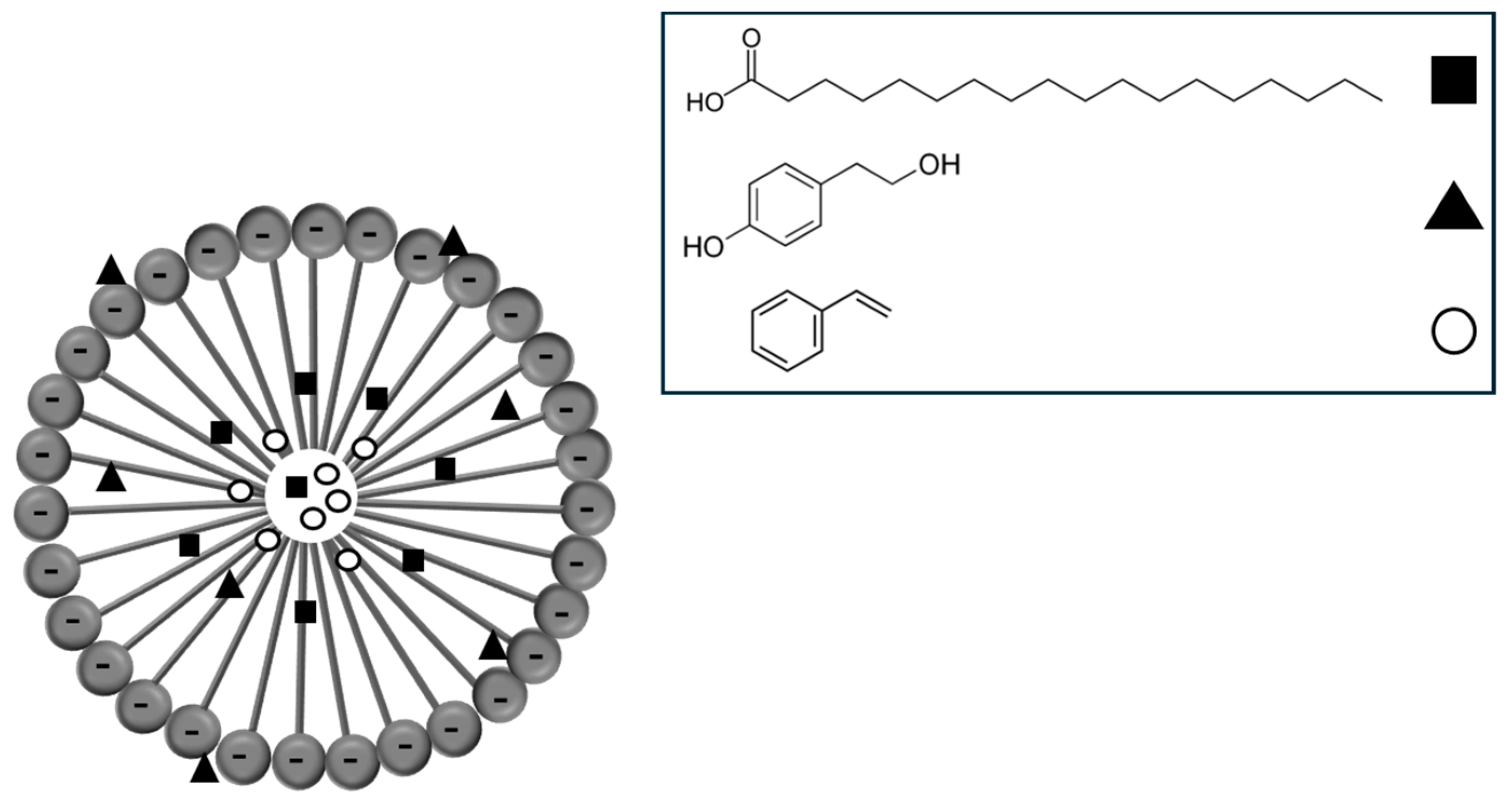
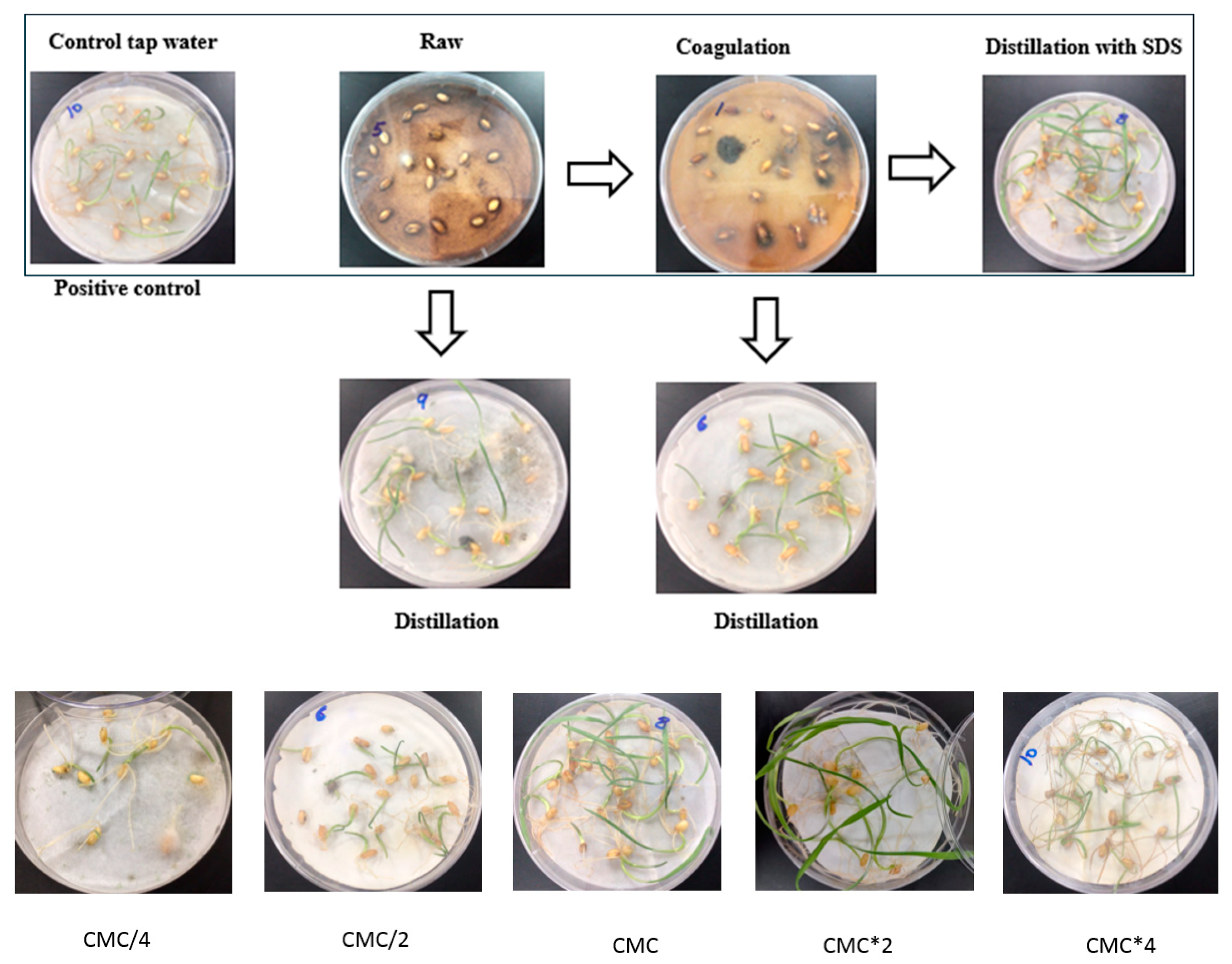
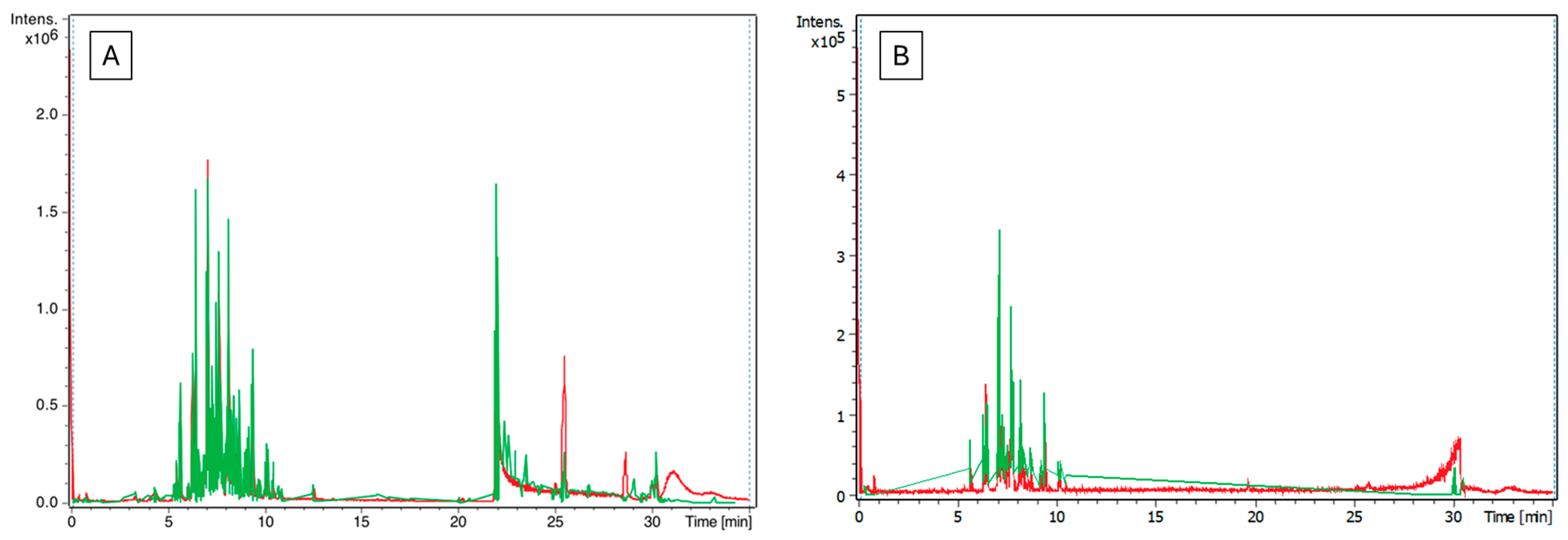
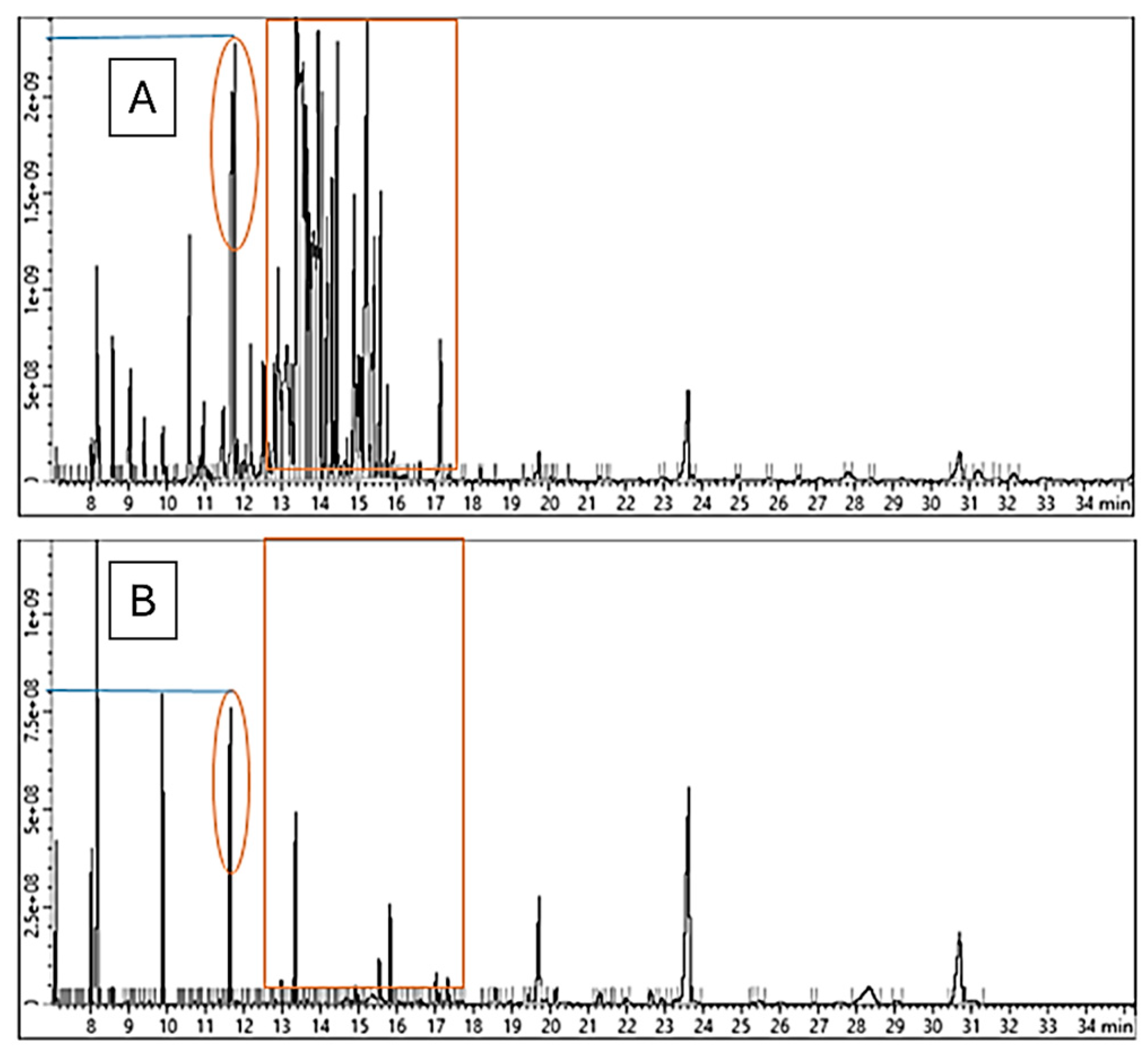
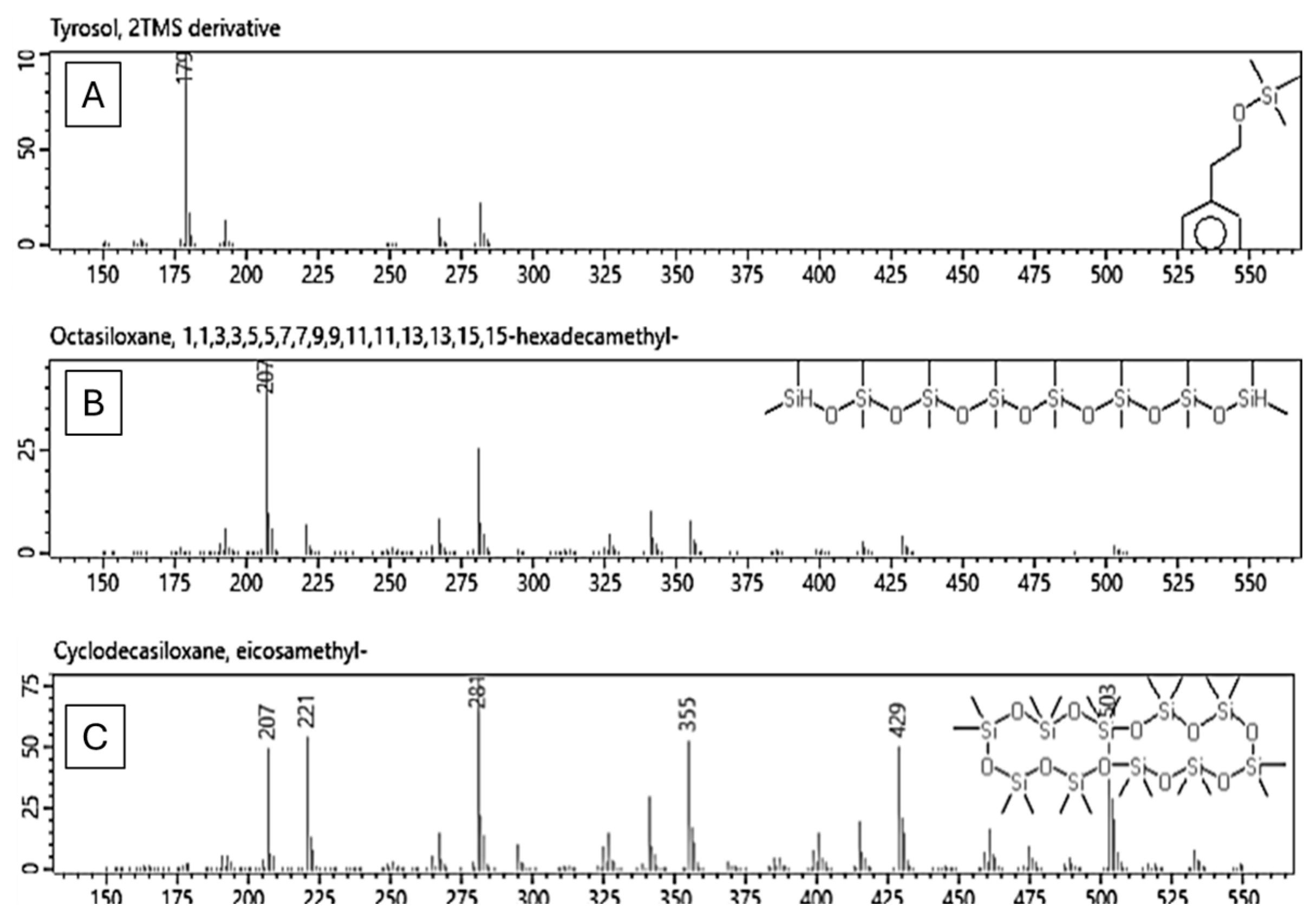

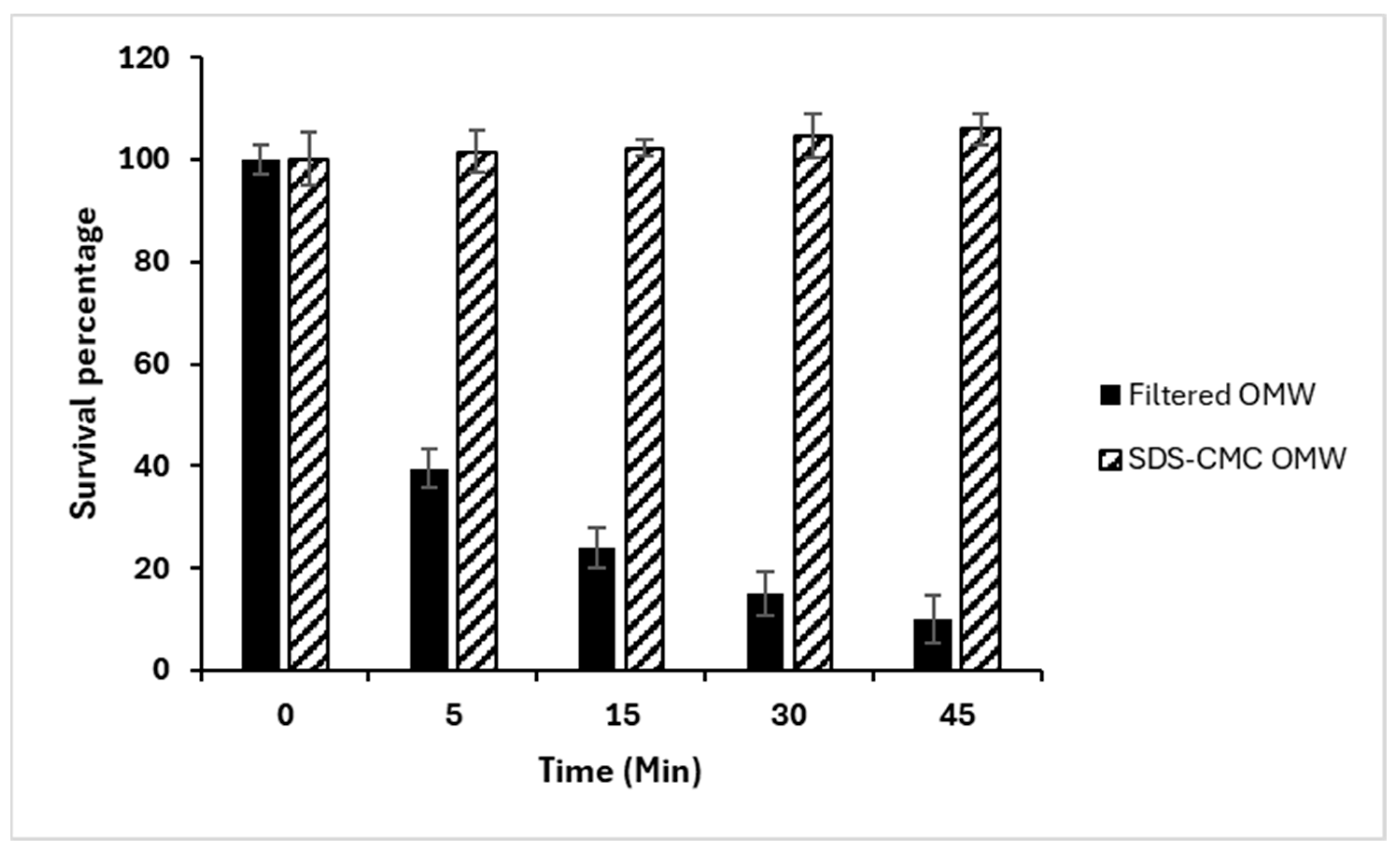
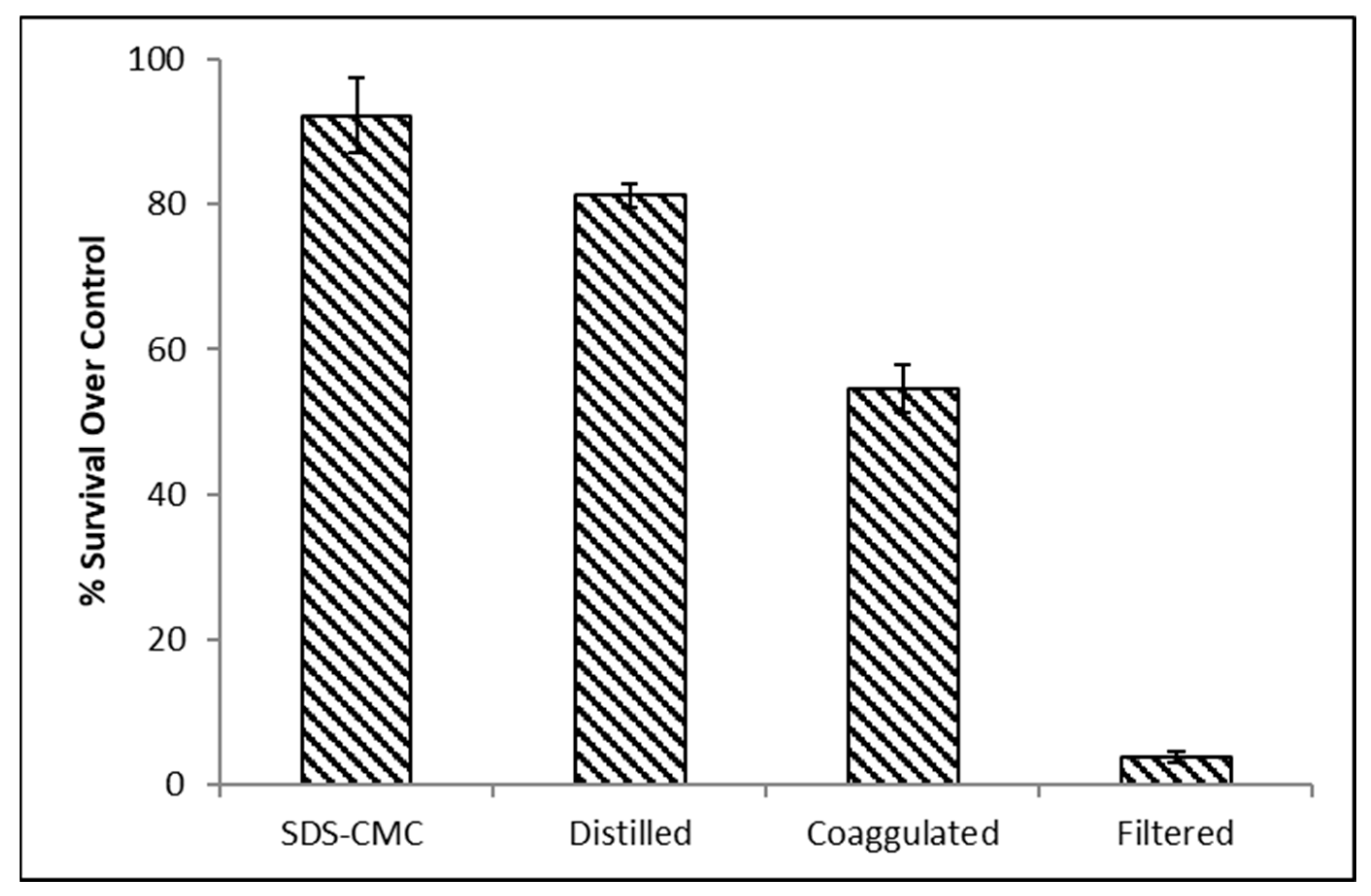
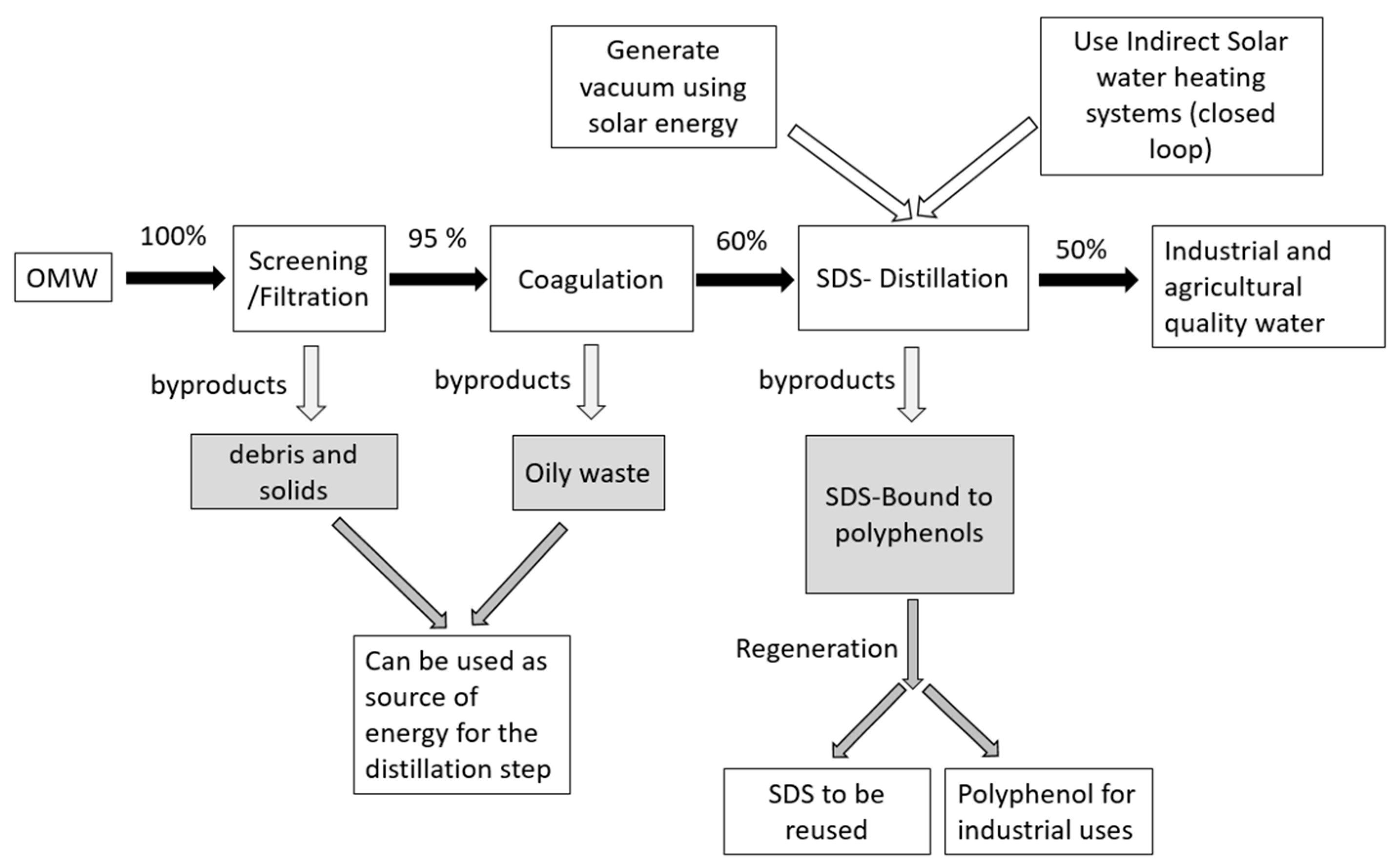
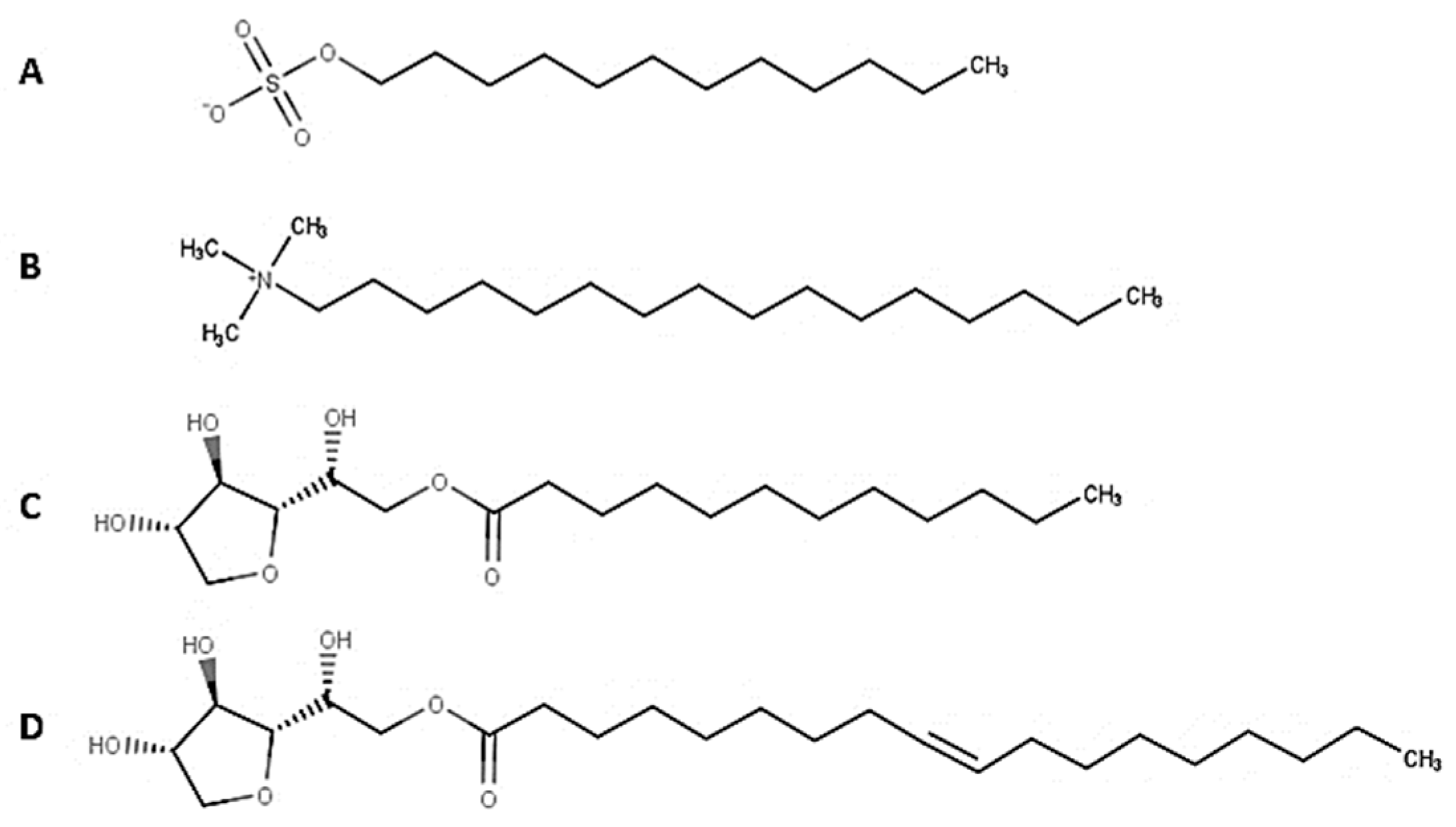
| Treatment Step | Residual Phenols % |
|---|---|
| Coagulation | 43 ± 7.1 |
| Distillation of coagulated OMW | 11.9 ± 2.2 |
| Distillation of coagulated OMW + SDS | 2.5 ± 0.6 |
| Distillation of coagulated OMW + span 80 | 14 ± 2.1 |
| Distillation of coagulated OMW + span 20 | 11 ± 1.6 |
| Distillation of coagulated OMW + CTAB | 11.2 ± 2.4 |
| Sample Name | Germination % | Stem Length % | Fungi Growth % |
|---|---|---|---|
| Control tap water | 100 | 100 | − |
| Raw OMW | - | - | + |
| Distilled Raw OMW | 40 | 50 | +++ |
| Coagulated OMW | - | - | +++ |
| Distilled Coagulated OMW | 50 | 80 | + |
| CMC Distillation | 100 | 100 | − |
| Sample Name | Germination % | Stem Length % | Fungi Growth % |
|---|---|---|---|
| CMC/4 | 60 | 40 | +++ |
| CMC/2 | 60 | 40 | + |
| CMC | 100 | 100 | − |
| CMC*2 | 100 | 100 | − |
| CMC*4 | 100 | 100 | − |
| Compound Name | Raw-Distilled | Raw-Coagulated-Distilled | Raw-Coagulated-Distilled- CMC | Source | Aromatic | Toxicity |
|---|---|---|---|---|---|---|
| Scopoletin | Yes | Yes | No | Natural | Yes | No |
| Capsaicin | Yes | Yes | Yes | Natural | Yes | No |
| Humulone | Yes | No | No | Natural | No | No |
| Caffeic Acid | Yes | No | No | Natural | Yes | No |
| Umbelliferone | Yes | Yes | Yes | Natural | Yes | No |
| 4-Tert-butyl 2-methylphenol | Yes | Yes | No | Synthetic | Yes | No |
| Tetramethrin | Yes | Yes | Yes | Synthetic—potent insecticide | No | Yes |
| Eusolex 6007 | Yes | Yes | No | Synthetic—Essential component in sunscreens | Yes | Yes |
| Isopentyl-4-methoxycinnamate | Yes | Yes | No | Synthetic—sunscreening agent. | Yes | Yes |
| Dodecylphenol | Yes | No | No | Synthetic—used in the manufacturing of epoxy resins | Yes | Yes |
| 4-Hydroxybenzoic acid n-butyl ester | Yes | Yes | No | Synthetic—bactericidal/fungicidal additives in cosmetics. | Yes | Yes |
| 4-n-Propylphenol | Yes | No | No | Synthetic—Food additive | Yes | No |
| Dibutylphthalate | Yes | Yes | Yes | Synthetic—plasticizer | Yes | Yes |
| Octocrylene | Yes | Yes | No | Synthetic—sunscreens and cosmetics | Yes | Yes |
| Hydrocortisone | Yes | Yes | Yes | Synthetic—Anti-inflammatory agent | No | No |
| (4 or 7) Hydroxy-Coumarin Plus Hydrate | Yes | Yes | No | Synthetic—Insecticides | Yes | Yes |
| Trans-nonachlor | Yes | Yes | No | Synthetic—Insecticides | No | No |
| 3-(2,2-Dichlorovinyl)-2,2-dimethylcyclopropene carboxylic acid | Yes | Yes | No | Synthetic—Pesticide | No | Yes |
| 4-hydroxybenzoic acid propyl ester | Yes | Yes | Yes | Natural | Yes | No |
| 4-Nonylphenol | Yes | Yes | Yes | Synthetic | Yes | Yes |
| Cyprodinil | Yes | Yes | No | Synthetic Fungicide | Yes | Yes |
| 2-ethylhexyl 3-(methoxyphenyl)-2-propenoate | Yes | Yes | Yes | Synthetwunscreen | Yes | Yes |
| Ethyl-4-aminobenzoate | Yes | Yes | Yes | Synthetic Local anesthetic | Yes | Yes |
| 3-Hydroxy-4-methoxycinnamic acid (isoferulic acid) | Yes | Yes | Yes | Natural | Yes | No |
| Hydroxyl tyrosol | Yes | Yes | No | Natural | yes | yes |
| Treatment Step | mg/L | Typical OMW Values [70] |
|---|---|---|
| Ni | 0.29 ± 0.05 | - |
| Cu | 0.25 ± 0.03 | 0.0021 (%) |
| Zn | 0.575 ± 0.09 | 0.0057 (%) |
| Mg | 376.036 ± 11.5 | 100–400 mg/L |
| K | 1343.48 ± 23.54 | 2700–7200 mg/L |
| Ca | 690.40 ± 12.4 | 120–750 mg/L |
| Mn | 0.88 ± 0.20 | 0.0015 (%) |
| Fe | 0.636 ± 0.08 | - |
| Sr | 6.789 ± 1.4 | - |
| Ba | 0.739 ± 0.17 | - |
| Li | 0.013 ± 0.006 | - |
| Na | 40.09 ± 2.4 | 40–900 mg/L |
| Hg | BDL | |
| Pb | BDL | - |
| Cd | BDL | - |
| As | BDL | - |
| Co | BDL | - |
| Mo | BDL | - |
| Treatment Step | COD (g/L) | % Removal |
|---|---|---|
| Filtered OMW | 124.6 ± 15.3 | 0 |
| Coagulated OMW | 108.0 ± 9.7 | 13.3 |
| Distilled OMW | 86.58 ± 7.5 | 30.5 |
| CMC step | 44.14 ± 4.3 | 65.6 |
Disclaimer/Publisher’s Note: The statements, opinions and data contained in all publications are solely those of the individual author(s) and contributor(s) and not of MDPI and/or the editor(s). MDPI and/or the editor(s) disclaim responsibility for any injury to people or property resulting from any ideas, methods, instructions or products referred to in the content. |
© 2024 by the authors. Licensee MDPI, Basel, Switzerland. This article is an open access article distributed under the terms and conditions of the Creative Commons Attribution (CC BY) license (https://creativecommons.org/licenses/by/4.0/).
Share and Cite
Akkam, Y.; Zaitoun, M.; Aljarrah, I.; Jaradat, A.; Hmedat, A.; Alhmoud, H.; Rababah, T.; Almajwal, A.; Al-Rayyan, N. Effective Detoxification of Olive Mill Wastewater Using Multi-Step Surfactant-Based Treatment: Assessment of Environmental and Health Impact. Molecules 2024, 29, 4284. https://doi.org/10.3390/molecules29184284
Akkam Y, Zaitoun M, Aljarrah I, Jaradat A, Hmedat A, Alhmoud H, Rababah T, Almajwal A, Al-Rayyan N. Effective Detoxification of Olive Mill Wastewater Using Multi-Step Surfactant-Based Treatment: Assessment of Environmental and Health Impact. Molecules. 2024; 29(18):4284. https://doi.org/10.3390/molecules29184284
Chicago/Turabian StyleAkkam, Yazan, Mohammad Zaitoun, Islam Aljarrah, Aiman Jaradat, Ali Hmedat, Hassan Alhmoud, Taha Rababah, Ali Almajwal, and Numan Al-Rayyan. 2024. "Effective Detoxification of Olive Mill Wastewater Using Multi-Step Surfactant-Based Treatment: Assessment of Environmental and Health Impact" Molecules 29, no. 18: 4284. https://doi.org/10.3390/molecules29184284
APA StyleAkkam, Y., Zaitoun, M., Aljarrah, I., Jaradat, A., Hmedat, A., Alhmoud, H., Rababah, T., Almajwal, A., & Al-Rayyan, N. (2024). Effective Detoxification of Olive Mill Wastewater Using Multi-Step Surfactant-Based Treatment: Assessment of Environmental and Health Impact. Molecules, 29(18), 4284. https://doi.org/10.3390/molecules29184284






